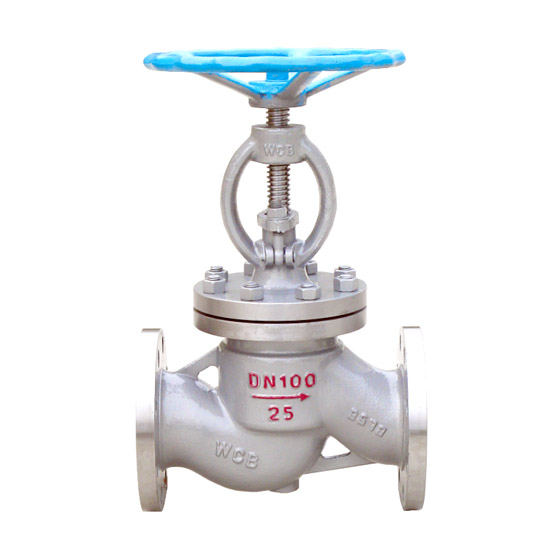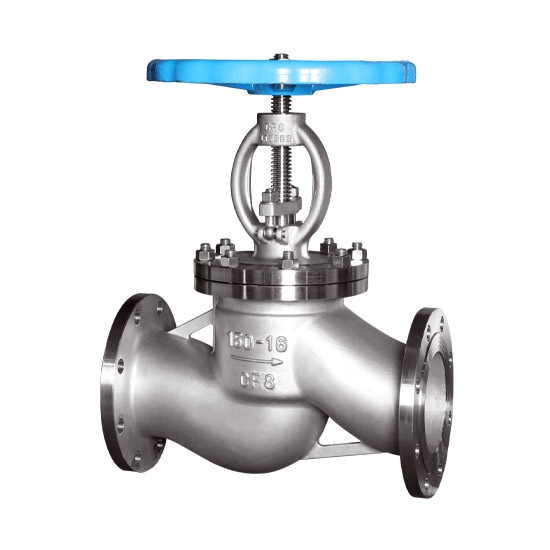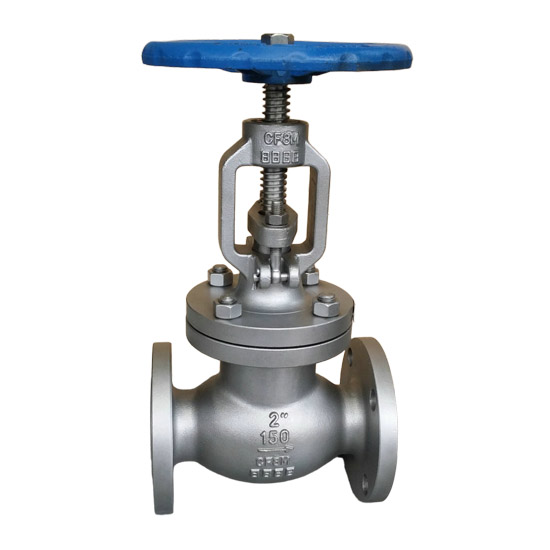I. Product Overview
The globe valve is a shut-off valve that controls the flow of medium by vertically raising or lowering the disc along the stem. It is integrated into pipeline systems via flanged connections. Its key features include:
• Metal-to-metal hard seal design: The sealing surfaces of the disc and seat are made of stainless steel overlay (Cr13 series) or Stellite alloy, ensuring zero leakage under high temperature and high pressure conditions. Suitable for clean or mildly corrosive media such as water, steam, and oil.
• Rising stem drive system: The stem moves with the disc and is fully exposed (trapezoidal thread drive). The number of handwheel rotations intuitively indicates the valve opening (fully open → stem at top; fully closed → stem at bottom).
• Unidirectional flow adaptability: The medium flow direction must strictly follow the arrow marked on the valve body (typically low-in, high-out, i.e., inlet below the disc, outlet above), ensuring that medium pressure assists sealing during closure.
• Compact and efficient structure: Straight-through flow path design (higher flow resistance but strong shut-off capability), suitable for full open/full close operation. Not to be used for throttling or flow regulation.
• Multiple actuation options: Supports manual (handwheel / worm gear), electric, pneumatic, or gearbox drive to meet varying automation requirements.
II. Model and Technical Parameters
1. Model Coding System
Example: J41H-16C
• J: Globe valve type • 4: Connection type (flanged; alternatives: welded – J61H, threaded – J11H) • 1: Structure type (straight-through single disc; angle type – J44H) • H: Sealing surface material (stainless steel overlay; others include Y – Stellite alloy, W – body seal) • 16: Nominal pressure (PN16, 1.6 MPa) • C: Body material (WCB carbon steel; others include P – 304 stainless steel, I – chrome-moly steel)
Other common models: • J41Y (Stellite seal) • J941H (electric type) • J641H (pneumatic type)
2. Technical Parameters
| Item | Parameter Range |
|---|---|
| Nominal Diameter (DN) | DN10~DN600 mm (larger sizes customizable) |
| Nominal Pressure (PN) | PN1.6~PN16.0 MPa (Class 150~1500) |
| Operating Temperature | -29℃~425℃ (standard stainless steel seal); -29℃~550℃ (Stellite alloy seal) |
| Applicable Media | Water, steam, oil, mildly corrosive liquids (nitric acid / acetic acid ≤200℃), natural gas |
| Strength Test Pressure | 1.5×PN (≥15 min pressure holding without deformation or leakage) |
| Sealing Test Pressure | 1.1×PN (≥15 min bidirectional pressure holding without leakage) |
| Body / Bonnet Material | WCB (carbon steel), CF8 (304), CF8M (316), WC6 (chrome-moly steel), LCB (low-temperature steel) |
| Disc / Seat Seal Surface | Stellite alloy overlay, hardened stainless steel (Cr13STL) |
| Stem Material | 2Cr13 (corrosion-resistant), 304/316 stainless steel, nitrided (anti-scuffing) |
| Packing Seal | Braided flexible graphite (for high-temperature steam) or reinforced PTFE (high chemical compatibility) |
| Flange Standards | GB/T 9113 (Chinese standard), ASME B16.5 (American standard), JIS (Japanese standard) |
III. Structural Features and Working Principle
1. Core Component Analysis
• Wedge-type disc: Flat or conical sealing surface, forced against the seat by stem thrust. Under high pressure, medium pressure assists sealing (unidirectional flow design).
• Metal-to-metal hard seal mechanism: Disc and seat use materials with differential hardness (seat slightly harder), reducing scuffing risk. Dual sealing via forced wedge fit + medium pressure self-tightening ensures zero leakage.
• Rising stem drive advantages: – Visual opening indication: Exposed stem length directly reflects disc position (fully closed → stem retracted; fully open → stem at top) – Trapezoidal thread efficiency: Handwheel rotation converted to linear motion via nut; worm gear mechanism reduces torque for large-diameter valves – Triple sealing protection: Flexible graphite packing + metal bellows ring + gland design significantly reduces stem leakage risk
2. Operating Mechanism
• Opening process: Counterclockwise rotation of handwheel raises stem, disc lifts off seat, flow path opens (flow resistance coefficient ≈16~20, higher than gate valve)
• Closing process: Clockwise rotation lowers disc to seat, forced wedge fit + medium pressure self-tightening shuts off medium. After full opening, reverse 1/4~1/2 turn to compensate thermal expansion and prevent stem lock-up
IV. Technical Standards
1. Compliance Standards
• Design Codes: GB/T 12235 (steel globe valves), ASME B16.34 • Test Standards: GB/T 13927, API 598 • Connection Standards: GB/T 9113 (Chinese flanges), ANSI B16.5 • Special Certifications: – NACE MR0175 (sour service resistance) – ATEX (explosion protection) – CRN (Canadian pressure vessel registration)
热门标签: globe valve /




